Day 8 - Friday, July 11
Saint Petersburg, Russia


Our first stop took us out of St. Petersburg to the nearby town of Pushkin and Catherine's Palace, where we were greeted by a brass band playing familiar tunes. Also called the Summer Palace, it was originally built by and for Tsarina Elizabeth, but she died before she could move in, so Catherine the Great was its first occupant. We waited briefly behind the ornate gates for the palace to open for visitors, then were ushered into a long courtyard, the sun just peeking above the roof of the palace. The outside is painted sky blue with white trim, although the ornate decorative elements are no longer carved and gilded with gold leaf but cast from moldings in an inexpensive bronze-ish color material. We entered a foyer where we were given brown fabric booties to put on over our shoes to protect the floors. Thus outfitted, we began the tour.





Natalia was short, so to make herself visible to the group, she carried a yellow compact umbrella rather than the standard stick-with-numbered-logo that identified most other excursion guides. Even so, the umbrella at full extension was not easy to spot in the crowd, so Lauri and Jill simply looked for Mark's ballcap. Filed through a number of rooms in sequence. The palace is one incredibly long building, and many of the rooms spanned the full width of the structure, windows on both outside walls, and doors leading north and south into adjacent rooms (no hallways). As huge as the rooms were, mirrors along the walls and between the windows made some rooms seem even larger. And, the edict against gold leaf obviously did not apply to the interior. Everywhere we looked we saw amazing details: parquet floors, mural ceilings, ornately gilded walls, panoramic rugs, life-sized oil portraits, etc. We learned that much of the palace had to be rebuilt and restored following the damage from World War II. Fortunately, a lot of artwork and other priceless elements had been spirited away for safekeeping in the Ural Mountains by workers at the palace prior to Nazi bombardment. The palace has since been furnished and decorated much as it was in Tsarist times, the one exception being the blank walls. What had once been adorned with intricate wallpaper is now merely painted.




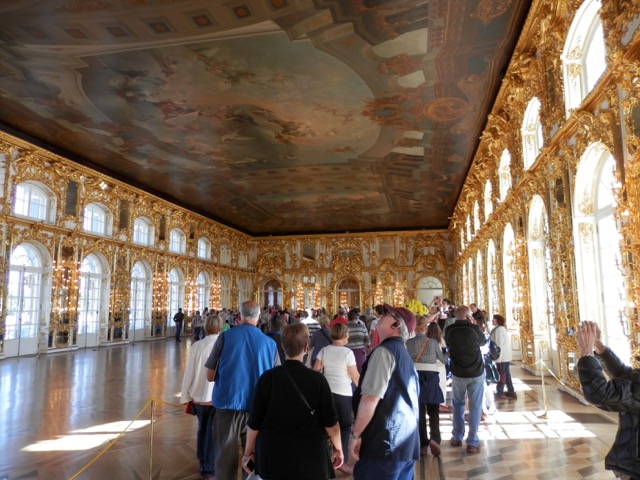





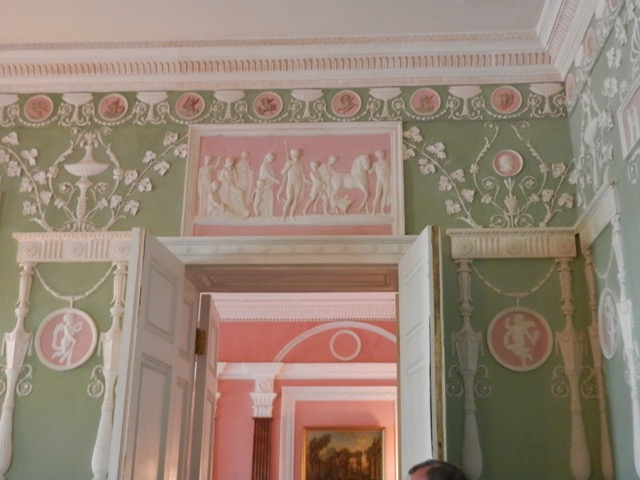
Jill found an ATM near the exit. She conferred with Natalia about lunch prices, as meals weren't included in the excursions, and we were told that Russia did not accept other currencies. Armed with some local cash, We exited the palace on the east side onto a broad esplanade of crushed rock overlooking the sprawling gardens. The palace is apparently a popular venue for weddings, judging by the number of bridal gowns we saw on the myriad pathways that snake through the scultptured and wooded grounds. We rested a bit and took more pictures, including the northern part of the palace which hid renovation work behind a scaffold covered by a full-scale printed tarp showing what the building facade would look like if not under construction. Maybe it's a European thing, as we saw the same type of setup on the cathedral in Barcelona. Also on the north side of the palace was the chapel, a cluster of gilt onion domes dazzling in the bright morning sun.


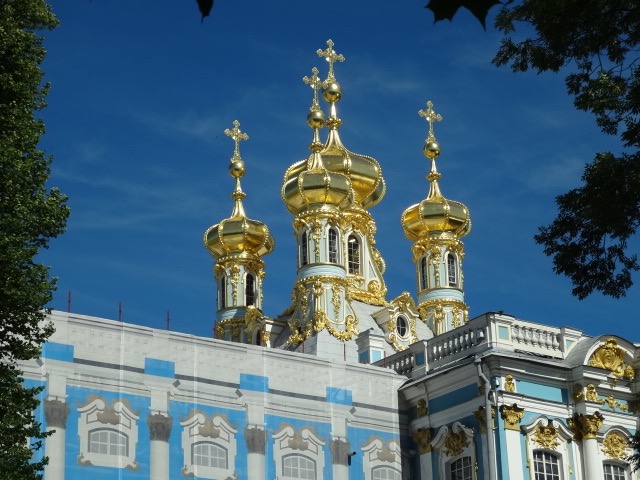
On the way back to the bus, we strolled down a walkway lined with kiosks touting all sorts of cheap and not-so-cheap souvenirs, everything from key-chains to t-shirts, matryoshka dolls to watercolors. We didn't buy anything. The bus took us back to St. Petersburg, as we snapped numerous photos through the window of various churches and other buildings.
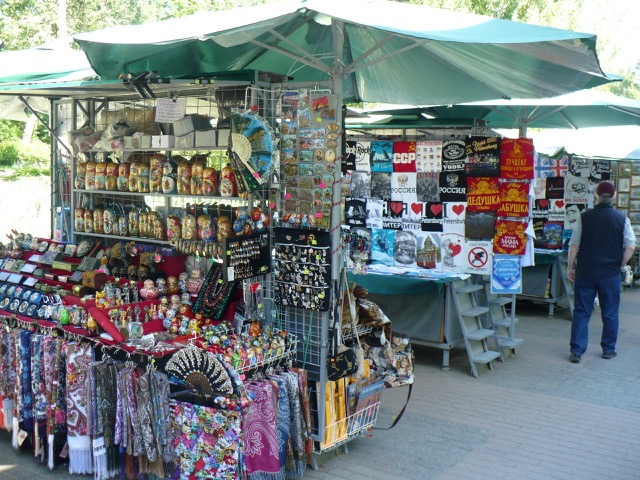

Our next stop was St. Isaac's Cathedral. After leaving the bus, we walked up steps between huge purple columns and passed through numbered gates and a metal detector alongside massive, carved black doors. The cavernous interior of St. Isaac's is richly decorated and, of course, devoid of pews. It is the third largest church dome in the world, we heard, after St. Peter's in Rome and St. Paul's in London. A few massive chandeliers provided some illumination at the floor level, but most of the light came from above, as sunlight glazed the opulent paintings and reflected off the giltwork and marble of the inside of the dome before spilling onto walls and floor. The highlight of St. Isaac's is the altar, or more precisely, the entire wall behind the altar. A sculptured arch in the center frames a tall stained-glass window, with paintings above and to both sides (including St. Isaac himself in a prominent position--second to the right, next to Jesus) nestled between columns of bright green marble. We took lots of pictures, including some of the surrounding buildings as we trod the sidewalk back to the bus. Drove by the big statue of Peter the Great, astride a horse rearing up on a granite boulder. It seems we passed that statue dozens of times during our tours of SP, from every conceivable direction. Drove along the Neva. Hard not to do, since the river forks into three branches before reaching the Baltic, and the city is spread across all of them.

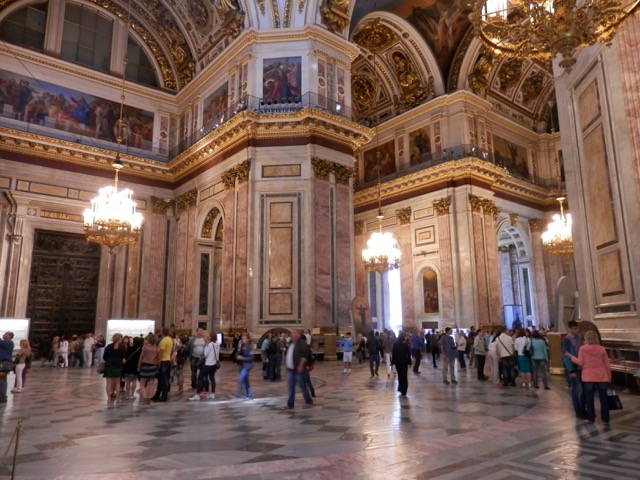








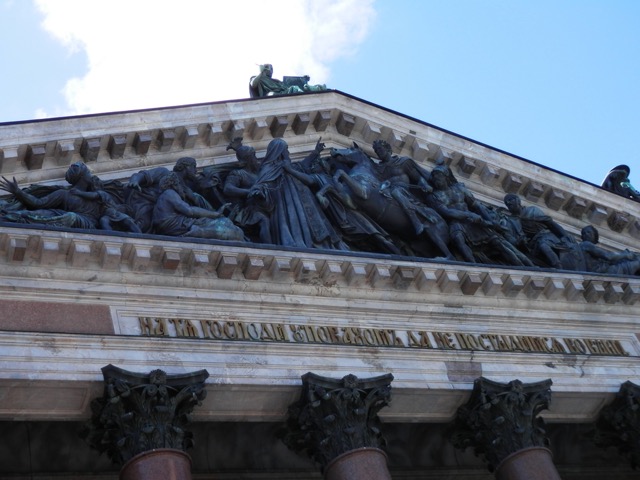

We parked at an industrial-looking building that had been converted from an old train station into a shopping mall. And like all malls, it featured a food court, and that's where we stopped for lunch. We had no interest in the McDonalds or KFC, preferring to try something local. Found a blini (crepe) place called Teremado (providing I transcribed the name correctly from the Cyrillic). We learned later that it was a fast-food chain as well. (At least it was Russian.) Jill and Lauri stuck with the traditional cheese and mushroom fillings. I found an offering on the picture-menu that looked interesting called a royale. Turns out, it was a standard western cheeseburger chopped up in a crepe instead of served on a bun. So much for being adventurous. Back to the bus.
Our next photo shoot was at a park on a point of land formed by a split in the river, a broad grassy semi-circle adorned with flower beds and bordered by arcs of well-trimmed trees and a concrete walkway along the perimeter at the water's edge. Also a popular spot for weddings. We enjoyed the weather and the views across the Neva to the Winter Palace, the Peter and Paul Fortress, an old wooden sailing ship, hydrofoils and other boats criss-crossing the waters.








From there it was a short bus ride past military barracks to the Aurora, a pre-WW1-era cruiser of the Imperial Navy, permanently moored along the edge of the river as a naval museum. At first glance, the flag at the bow looked British, but a closer view revealed the differences: the Imperial Navy banner is blue and white crosses on a red background; the Union Jack is red and white on a blue background. Plus, the flag flying over the Aurora emphasized the x over the +, opposite of the UK.



Took a shopping break after that, stopping for a few minutes at a large souvenir store. Bypassed the long stretch of staggered bins down the middle of the store that made it difficult to navigate, and focused on the big-ticket items in the alcoves along the side. Specifically, the traditional bearskin hat replicas, complete with tin Soviet military insignia on the front. Lauri and Jill found colors and sizes they liked right away, but Mark had to search through what seemed like their entire stock. He wanted a black hat, to match his winter coat, but they had nothing larger than 61 in that color. He found a size 62 among the light coppery-brown hats, so rang that up and dashed back to the bus. By the way, the store listed prices in rubles, euros, and dollars, so at least some places accepted foreign currency.
More shots of buildings as we continued our bus tour, including another pass at Peter and his horse. And then it was back to the ship, where we found long lines at the passport booths again, so that we might properly be checked out of the country. Seemed unnecessary to me, as we planned to be back in the morning.
We had discussed the idea of sampling some of the St. Petersburg nightlife (or even evening-life), but the long excursion caught up with us, and we decided to stay aboard for the rest of the day. We may have rested or napped for a bit, but eventually we hit the Ocean Bar for a couple of drinks, then scoped out the pictures at the gallery. Not surprisingly, we opted to purchase the package deal, which includes all our shipboard photos, both prints and digital files on a CD, for one price. Lots cheaper than buying the shots individually.
Took a walk to kill time until dinner, but then discovered that the dining room was open seating that night, meaning we could have walked in at any time, but we had missed the announcement telling us that. Oh well. For us, no nightlife aboard ship, either. After dinner we hit the hay.